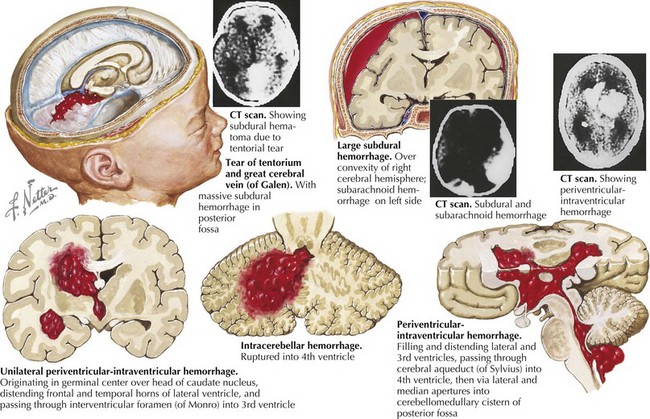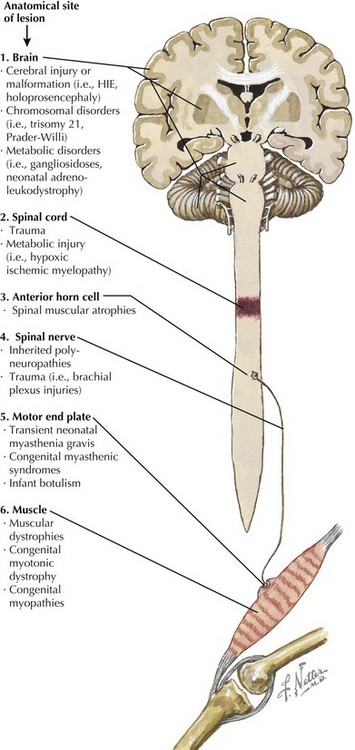101 Disorders of the Nervous System
Etiology and Pathogenesis
Intraventricular Hemorrhage
Although the premature cerebrovasculature has reasonable capacity for autoregulation within the normal range of blood pressure, this mechanism quickly becomes inadequate as blood pressures fluctuate outside the norm, predisposing the brain to ischemic injury during times of hypotension and hemorrhagic injury during times of hypertension. The periventricular germinal matrix of the premature brain is at high risk for hemorrhagic injury because of the presence of a rich but relatively immature capillary network. This region is particularly critical because it harbors the neural stem and progenitor cell population that provides precursors necessary for future myelination and development of the brain. Figure 101-1 demonstrates patterns of hemorrhagic injury that can occur in both premature and term infants.
Neonatal Seizures
Neonatal seizures are often a manifestation of underlying neurologic disease or injury (Table 101-1). In each case, the metabolic or structural abnormalities cause disorganized electrical activity that can lead to epileptogenic foci.
Neonatal Hypotonia
Hypotonia is a common sign of neurologic disease in newborns that can be caused by dysfunction anywhere along the neuromuscular axis. These may arise from genetic defects causing protein dysfunction in either nerve or muscle cells, loss of cerebral regulation of tone secondary to global central nervous system (CNS) dysfunction as in many chromosomal disorders or injuries, or disturbed signal transmission at the neuromuscular junction. The more common causes of hypotonia can be organized by the location of the primary defect (Figure 101-2).
Clinical Presentation
Neonatal Seizures
Neonatal seizures have a variety of manifestations and a variety of normal mimics (Box 101-1). Clonic seizures can occur either focally or multifocally and are repetitive high-amplitude, low-frequency jerking movements. Tonic seizures are constant stiffening of a portion of the body and may be focal or generalized. Myoclonic seizures include sudden extension or flexion of part of the body. Subtle seizures encompass other small abnormal movements that do not fit into the previously listed seizure types, including eye deviation, lip smacking, and tongue thrusting, among others. Subtle seizures and generalized tonic seizures often do not have electroencephalographic (EEG) correlates and are thought to emanate from deeper subcortical brain regions, a theory supported by animal studies.
Stay updated, free articles. Join our Telegram channel

Full access? Get Clinical Tree





